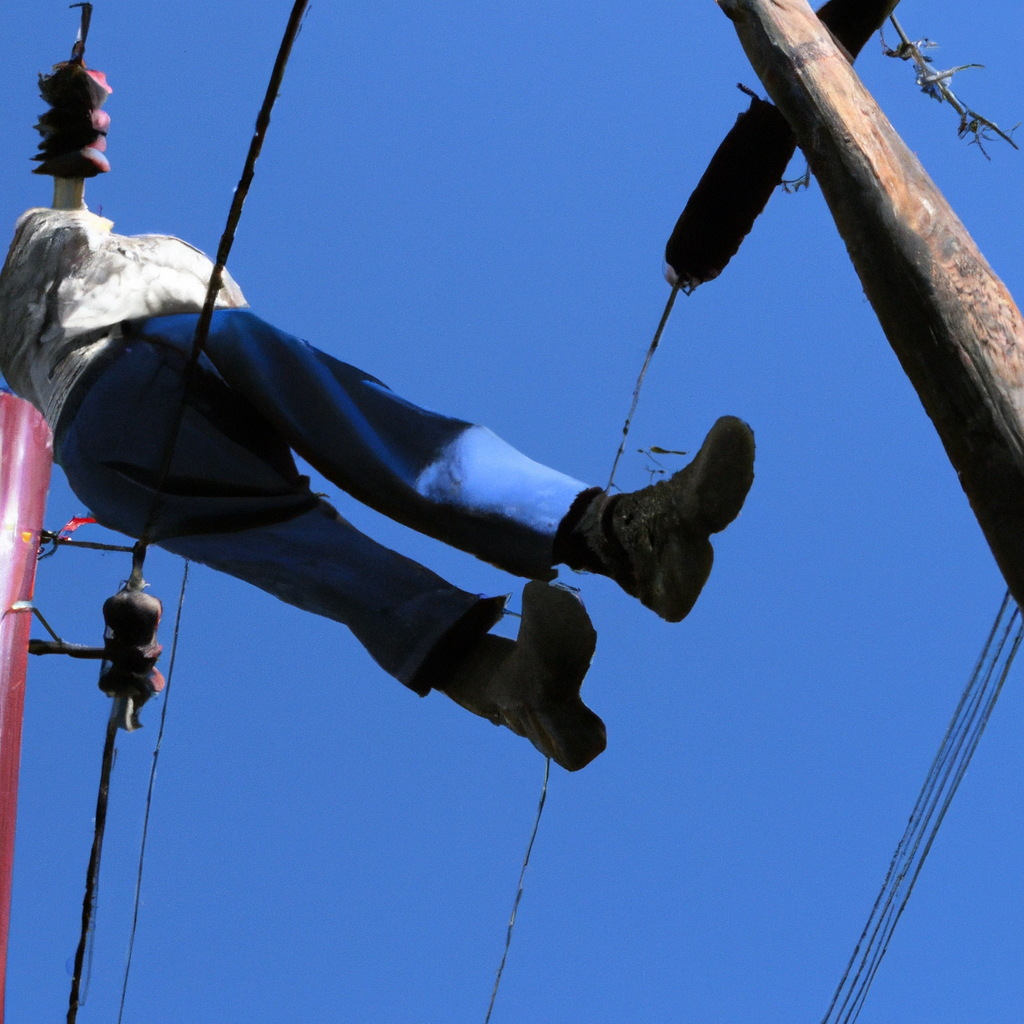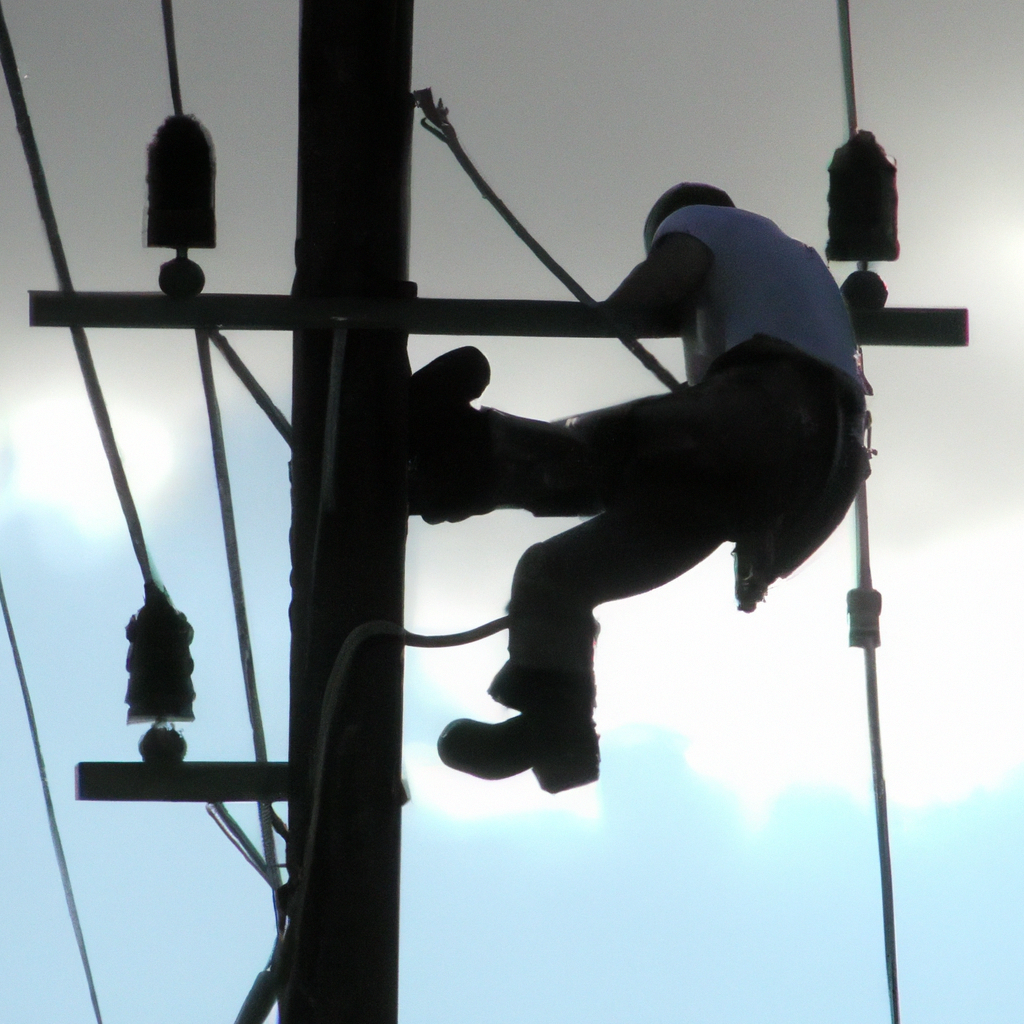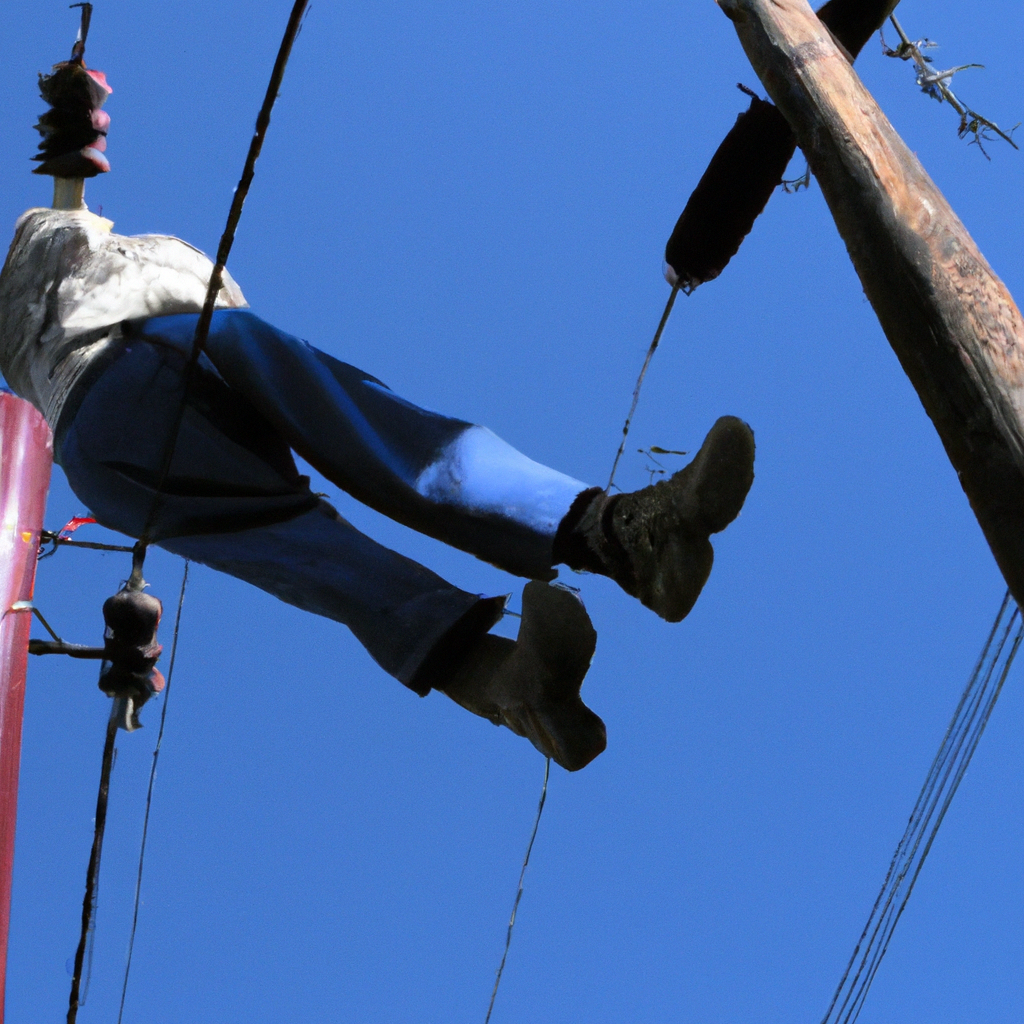Linemen, the unsung heroes who keep our electricity flowing, face a unique set of challenges on the job. Ever wondered what footwear these fearless individuals rely on to keep them safe and comfortable as they work high above the ground? From sturdy boots to specialized climbing shoes, linemen have a diverse range of options to choose from. In this article, we’ll take a closer look at the footwear choices of linemen and how they help them navigate the demanding terrain they face daily. So, buckle up and get ready to explore the world of lineman footwear!

The Importance of Proper Footwear for Linemen
As a lineman, your job involves physical labor and potentially hazardous conditions. Having the right footwear is crucial to ensure your safety, comfort, and overall performance. In this article, we will explore the importance of proper footwear for linemen, the different types of footwear available, important features to consider, and how to maintain your footwear to extend its lifespan.
The Physical Demands of Lineman Work
Linemen work in a variety of settings, including power lines, telecommunications towers, and construction sites. The nature of the job requires them to climb, balance, and maneuver in often challenging terrains and weather conditions. This physically demanding work puts a significant strain on the feet, making it essential to have footwear that offers adequate protection and support.
Safety Considerations
Safety should always be a top priority for linemen, and this includes ensuring their footwear meets the necessary safety standards. Linemen are exposed to a range of potential hazards, such as electrical shocks, falling objects, and slippery surfaces. Wearing appropriate footwear can significantly reduce the risk of injuries and accidents, providing crucial protection to a lineman’s feet.
Foot Protection
The feet are particularly vulnerable to workplace injuries, and linemen must prioritize foot protection. The right footwear should provide ample protection against common hazards, such as impact, punctures, electrical shocks, and slips or falls. By investing in well-designed footwear, linemen can minimize the risk of foot injuries and maintain their overall safety on the job.
Types of Footwear for Linemen
When it comes to choosing footwear for linemen, there are several options available, each with its own unique features and benefits. The three primary types of footwear commonly worn by linemen are work boots, safety shoes, and specialized lineman boots. Let’s take a closer look at each of these options.
Work Boots
Work boots are a versatile and popular choice among linemen due to their durability, comfort, and all-around performance. These boots are typically made of high-quality leather uppers that provide excellent protection against abrasions, cuts, and impacts. Work boots often feature reinforced toe caps, shock-absorbing midsoles, and high-traction outsoles to enhance stability and comfort during long hours on the job.
Safety Shoes
Safety shoes offer a more lightweight alternative to traditional work boots, without compromising on safety features. These shoes are often made with non-metallic safety toes, reducing the risk of electrical conductivity while still providing adequate impact protection. Safety shoes are designed with ergonomic features for added comfort and support, making them an excellent choice for linemen who prioritize agility and flexibility.
Specialized Lineman Boots
For linemen who require additional support and features specific to their line of work, specialized lineman boots are the ideal choice. These boots are designed with tall shafts to provide superior ankle support and stability during climbing and working at heights. Lineman boots often have climbing-specific features, such as steel shanks and heel cleats, to enhance grip and traction. Additionally, these boots may incorporate enhanced safety features to protect against electrical shocks and other hazards commonly encountered by linemen.
Features to Look for in Lineman Footwear
Regardless of the type of footwear you choose, there are several key features to consider when selecting the best lineman footwear for your needs. These features play a crucial role in providing the necessary protection, comfort, and functionality required for the demanding job of a lineman. Let’s explore some important features to look for in lineman footwear.
Steel Toes
Steel toes are essential for protecting your feet against potential impact and compression injuries. They provide an additional layer of reinforcement and can withstand heavy objects falling onto your toes. When selecting lineman footwear, ensure that it includes steel toe caps that meet or exceed safety standards such as ASTM (American Society for Testing and Materials) requirements.
Electrical Hazard Protection
As a lineman, you are constantly exposed to the risk of electrical shocks. It is vital to choose footwear that offers electrical hazard protection, such as insulation and non-conductive materials. Look for boots or shoes with a safety rating for electrical hazard protection, indicating that they can withstand up to a certain voltage level.
Slip Resistance
Working in various outdoor environments means encountering slippery surfaces, such as wet or oily surfaces. Slip-resistant outsoles are designed to provide excellent traction on these surfaces, reducing the risk of slips and falls. Look for footwear with outsoles made from rubber or other slip-resistant materials, featuring deep treads and patterns that maximize grip and stability.
Waterproofing
Linemen often work in all weather conditions and environments, including rain, snow, and mud. Having waterproof footwear is essential to keep your feet dry and comfortable throughout the day. Look for boots or shoes with waterproofing technologies, such as sealed seams or waterproof membranes, to ensure your feet stay protected from moisture.
Insulation
Working with electricity can generate heat, and linemen often find themselves in hot or cold environments. Insulated footwear can help regulate the temperature within the boot, keeping your feet warm in cold conditions and preventing excessive heat buildup. Look for boots or shoes with insulation materials, such as Thinsulate™ or Gore-Tex®, which provide effective temperature control.
Puncture Resistance
Sharp objects and debris on the job site pose a significant risk to linemen. Puncture-resistant footwear offers an additional layer of protection against puncture wounds, particularly in environments where nails, screws, or other sharp objects are present. Look for boots or shoes with puncture-resistant midsoles made of materials like Kevlar or steel.
Comfort and Support
Working long hours on your feet requires footwear that offers both comfort and support. Look for features like cushioned insoles, arch support, and shock-absorbing midsoles to minimize foot fatigue and discomfort. Remember to choose footwear with the right fit, as ill-fitting boots or shoes can contribute to blisters, calluses, or other foot problems.
Work Boots for Linemen
Work boots, known for their durability and reliability, are a go-to choice for many linemen. These boots are specifically designed to withstand the physical demands of the job, ensuring optimal performance and protection. Here are some key features commonly found in work boots for linemen:
Durable Leather Uppers
Quality work boots often feature durable leather uppers that provide excellent resistance against abrasions, cuts, and tears. Full-grain leather, in particular, offers superior durability and can withstand the rigors of lineman work. Leather uppers also provide a level of water resistance, keeping your feet dry in wet conditions.
Reinforced Toe Caps
To protect your toes from potential impact injuries, work boots for linemen often incorporate reinforced toe caps. These caps are typically made of steel or composite materials and are designed to withstand heavy objects falling onto the toes. Reinforced toe caps are key to ensuring the safety and longevity of your footwear.
Shock-Absorbing Midsoles
The constant impact and strain on your feet require boots with effective shock absorption. Work boots for linemen often feature shock-absorbing midsoles made of materials like EVA (ethylene-vinyl acetate) or polyurethane. These midsoles provide cushioning and help reduce the stress on your feet, minimizing the risk of fatigue and discomfort.
High-Traction Outsoles
Working in various terrains and environments requires boots with reliable traction to prevent slips and falls. High-traction outsoles with aggressive tread patterns are commonly found in work boots for linemen. These outsoles, often made of rubber or similar materials, provide excellent grip and stability on different surfaces, ensuring your safety and confidence on the job.

Safety Shoes for Linemen
While work boots are a popular choice, safety shoes offer a lighter and more flexible alternative for linemen who prioritize agility and flexibility. These shoes provide the necessary safety features while allowing for greater freedom of movement. Here are some key features commonly found in safety shoes for linemen:
Lightweight Design
Safety shoes for linemen are typically constructed with lightweight materials to reduce fatigue and enhance comfort during long hours on the job. These shoes often incorporate composite safety toes, which are lighter than traditional steel toes, without compromising protection. The lightweight design of safety shoes allows for increased agility and freedom of movement.
Non-Metallic Safety Toes
To protect against impact injuries, safety shoes for linemen often feature non-metallic safety toes made of composite materials like carbon fiber or Kevlar. These safety toes provide a high level of protection while eliminating the risk of electrical conductivity. Non-metallic safety toes are an excellent choice for linemen working near electrical equipment or power lines.
Electrical Hazard Protection
Given the electrical risks faced by linemen, safety shoes should provide adequate electrical hazard protection. Look for footwear that meets or exceeds electrical hazard safety standards, such as ASTM F2412-18 and ASTM F2413-18. These standards ensure that the footwear can provide a degree of insulation and protection against electrical shocks.
Ergonomic Features
Safety shoes for linemen are designed with ergonomic features to enhance comfort and reduce the strain on your feet. Look for shoes with cushioned insoles, arch support, and shock-absorbing midsoles to minimize fatigue and promote overall foot health. Ergonomic features contribute to greater comfort and can help prevent common foot ailments and injuries.
Specialized Lineman Boots
For linemen facing more challenging work environments and requiring specialized features, dedicated lineman boots are the ideal choice. These boots are specifically designed to meet the unique demands of lineman work, providing maximum protection and performance. Here are some key features commonly found in specialized lineman boots:
Tall Shafts
Specialized lineman boots typically have tall shafts that provide superior ankle support and stability, especially during climbing and working at heights. The added height helps prevent ankle injuries and allows for a secure fit when using climbing gear or safety harnesses. Tall shafts also protect against debris or objects entering the boot.
Climbing-Specific Features
Lineman boots often incorporate climbing-specific features to enhance grip and traction when working on utility poles or towers. These features may include steel shanks for added stability, heel cleats for improved climbing grip, and specialized outsoles with tread patterns that provide optimal grip on a variety of surfaces. Climbing-specific features are essential for linemen who regularly engage in climbing activities.
Additional Ankle Support
The nature of lineman work involves constant movement and potential hazards that can impact ankle stability. Specialized lineman boots are designed to provide additional ankle support through features like padded collars, ankle straps, or lace systems. The added ankle support helps reduce the risk of twists or sprains, ensuring the safety and comfort of the lineman.
Enhanced Safety Features
As with any lineman footwear, specialized lineman boots incorporate essential safety features. These may include steel toe caps, electrical hazard protection, and puncture-resistant midsoles. Specialized lineman boots often meet specific safety standards, such as ASTM F2413-18, ensuring they can withstand the hazards commonly encountered by linemen.
Considerations for Electrical Work
For linemen engaged in electrical work, there are specific considerations to keep in mind when choosing footwear. Electrical work presents unique hazards that require additional safety features and precautions. Here are some key considerations for linemen working with electricity:
Electrical Shock Protection
Electrical shock protection is of utmost importance for linemen working with live electrical equipment or power lines. Look for boots or shoes that provide electrical hazard protection, indicated by a safety rating or certification. Such footwear is designed to minimize the risk of electrical shocks by providing insulation and preventing the flow of electrical current through the foot.
Dielectric Materials
Dielectric materials are non-conductive materials that prevent the flow of electrical current. For linemen working with electricity, boots or shoes made with dielectric materials are crucial. These materials provide an additional layer of protection against electrical shocks by acting as insulators. When selecting footwear, ensure it is made with dielectric materials and meets the relevant safety standards.
Insulation Level Requirements
Different work environments and tasks may necessitate specific insulation levels in footwear. Linemen working in cold conditions or on projects involving high voltages may require boots or shoes with higher insulation levels. Insulation thickness is typically measured in grams, with higher gram ratings providing more warmth. It is important to assess your specific work environment and insulation needs when choosing footwear.
Other Factors to Consider
While safety features and functionality are essential when choosing lineman footwear, there are several other factors to consider. These factors can help you make a well-informed decision that takes into account your personal preferences, budget, and overall satisfaction. Here are some additional factors to consider:
Price Range
The price range of lineman footwear can vary significantly based on factors such as brand, quality, and additional features. Set a budget that aligns with your needs and expectations, considering the importance of investing in high-quality footwear to ensure safety and durability. Remember that while cost is a valid consideration, it should not be the sole determining factor in your decision.
Brand Reputation
When it comes to safety and reliability, brand reputation plays a vital role. Choose footwear from reputable brands known for producing high-quality products that meet industry standards. Research and read reviews to gauge the reputation of different brands regarding their lineman footwear offerings. Opting for reputable brands can provide peace of mind and assurance in the performance and durability of your chosen footwear.
User Reviews
User reviews are an invaluable resource when assessing the comfort, fit, and overall satisfaction of lineman footwear. Take the time to read reviews from other linemen who have purchased and worn the footwear you are considering. Pay attention to feedback regarding fit, durability, and specific features to gain insights into the real-world performance of the footwear you are interested in.
Proper Fit
One of the most critical factors in selecting lineman footwear is ensuring a proper fit. Ill-fitting boots or shoes can lead to discomfort, blisters, and foot fatigue. Take accurate measurements of your feet and refer to sizing charts provided by the manufacturer. Some brands may offer specific width options, ensuring a more customized fit. When possible, try on the footwear before purchasing or consider brands that offer hassle-free returns or exchanges if the fit is not ideal.
Maintaining Lineman Footwear
Once you have invested in quality lineman footwear, it is essential to maintain it properly to maximize its lifespan and performance. Regular cleaning, inspection, and conditioning can significantly extend the durability and functionality of your footwear. Here are some maintenance tips for keeping your lineman footwear in optimal condition:
Regular Cleaning and Inspection
After each use, clean your lineman footwear to remove dirt, debris, and any substances that may compromise its integrity. Use a soft brush or cloth to remove surface dirt and rinse off any excess mud or grime. Inspect your footwear for any signs of damage, such as cuts, tears, or loose stitching. Regular cleaning and inspection allow you to address potential issues early and prevent further damage.
Conditioning the Leather
If your lineman footwear has leather uppers, it is vital to condition the leather regularly to maintain its suppleness and water resistance. Leather conditioners help prevent cracks, maintain the integrity of the leather, and extend its lifespan. Follow the manufacturer’s instructions for applying the conditioner, ensuring an even application. Regular conditioning will keep your leather boots or shoes looking and performing their best.
Replacing Worn-Out Footwear
Despite proper maintenance, lineman footwear will eventually wear out over time due to the rigorous demands of the job. Vigilantly monitor the condition of your footwear and proactively replace it when signs of significant wear and tear appear. Worn-out footwear compromises safety and may no longer provide the necessary protection and functionality. Investing in a new pair of lineman footwear is an investment in your safety and comfort on the job.
Conclusion
Investing in the right footwear is essential for linemen, considering the physical demands and potential hazards of the job. Whether you choose work boots, safety shoes, or specialized lineman boots, prioritize safety, comfort, and functionality. Key features such as steel toes, electrical hazard protection, slip resistance, waterproofing, insulation, puncture resistance, and comfort and support should guide your decision. Additionally, consider specific requirements for electrical work and other factors like price range, brand reputation, user reviews, and proper fit. Maintain your lineman footwear with regular cleaning, inspection, and conditioning, and promptly replace worn-out footwear. Choosing the best footwear for your needs ensures you can perform your job safely, comfortably, and with confidence.




